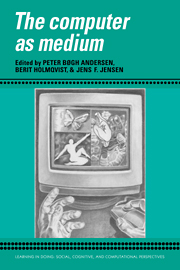Book contents
- Frontmatter
- Contents
- Series foreword
- Preface
- Contributors
- Part I Computer-based signs
- Introduction
- 1 A semiotic approach to programming
- 2 Structuralism, computation, and cognition: The contribution of glossematics
- 3 The shortest way between two points is a good idea: Signs, Peirce, and theorematic machines
- 4 Logic grammar and the triadic sign relation
- 5 Meaning and the machine: Toward a semiotics of interaction
- Part II The rhetoric of interactive media
- Part III Computers in context
- Index
Introduction
Published online by Cambridge University Press: 05 October 2010
- Frontmatter
- Contents
- Series foreword
- Preface
- Contributors
- Part I Computer-based signs
- Introduction
- 1 A semiotic approach to programming
- 2 Structuralism, computation, and cognition: The contribution of glossematics
- 3 The shortest way between two points is a good idea: Signs, Peirce, and theorematic machines
- 4 Logic grammar and the triadic sign relation
- 5 Meaning and the machine: Toward a semiotics of interaction
- Part II The rhetoric of interactive media
- Part III Computers in context
- Index
Summary
This part presents semiotic approaches to the design and analysis of computer systems. Theoretically, the five chapters range from classical structuralist methodology to new developments in catastrophe theoretical semantics to Peircean traditions. The programming paradigms include object-oriented programming, functional programming, and logic programming.
The chapters by Peter Bøgh Andersen, David Piotrowski, and Per Hasle establish semiotic frameworks for programming. Per Aage Brandt's chapter is concerned with the new kinds of semioses emerging in human-computer interaction, and Keld Gall Jørgensen discusses computer intelligence from a Peircean point of view.
I compare the approaches and coverage of the five chapters by discussing the problem of meaning and machines. The problem that has engaged philosophers like John Searle and Daniel Dennett is the following: Can computers be said to contain and process meaning, or do they just contain and process empty syntactical expression to which humans assign a content?
The concrete point of departure is the following simple fact: Through keyboard or mouse we can input data into the computer, which responds by writing or drawing on the screen or activating the loudspeaker. The input and output are assigned a meaning and thus form a composite sign. Meaning is produced, but how and by whom?
- Type
- Chapter
- Information
- The Computer as Medium , pp. 9 - 15Publisher: Cambridge University PressPrint publication year: 1994



